
 |
Photo History
Local Girl
324th Bomb Squadron, 42-3111
B-17F-25-DL 91/324-AI DF-A
Originally assigned to the 335th Bomb Squadron in May 1943, this aircraft was later transferred to the 324th BS 91st BG based at Bassingbourn. Renamed "Local Girl," it was lost over Emden 27 September 1943, crashing at Geefsweer, Holland.
These are reportedly photos taken from the crash site of "Local Girl."
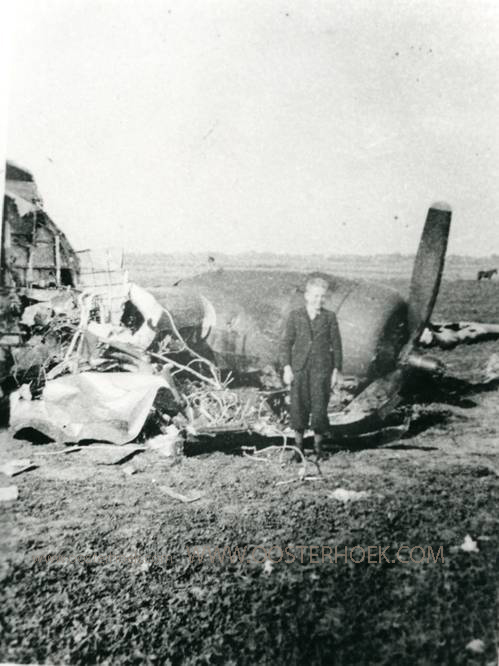
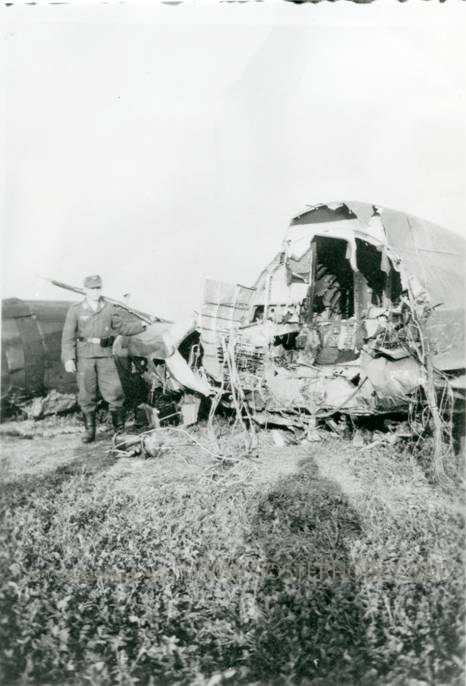
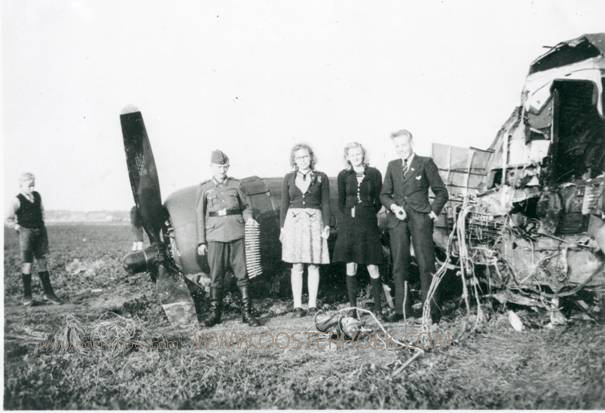
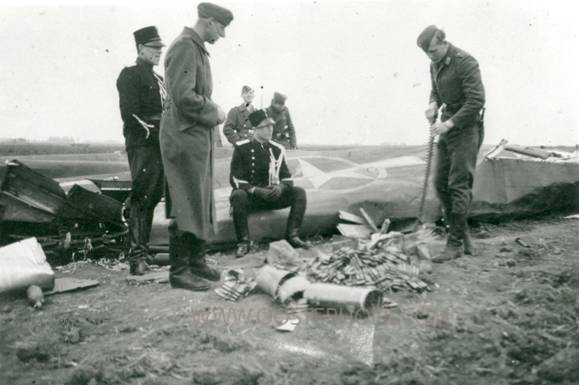
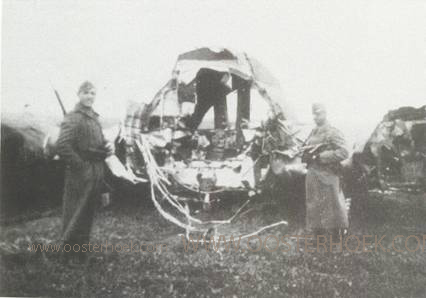
Crew of "Local Girl" (27 Sep 1943) |
(P) 2nd Lt. William G. Pegram (KIA) |
(CP) William L. Martin (POW) |
(N) 2nd Lt. Robert S. Cosgrove (KIA) |
(B) 2nd Lt. Norman C. Eatinger (POW) |
(TT) T/Sgt. Vernon C. Larsen (KIA) |
(RO) T/Sgt. Orlo G. Natvig (POW) |
(BTG) Paul R. Ayala (POW) |
(WG) S/Sgt. Frederick Hutchinson (POW) |
(WG) Sgt. Melvin J. Peters (KIA) |
(TG) Gordon E. Noel (POW) |
(4 KIA, 6 POW) (MACR 667) |
The mission on 27th September involved 300 heavy bombers and was the first operational use of radar-guided bombing on a German target. Emden had been chosen because of its coastal position which would be more clearly defined on the radar scopes in the event of overcase. Shortly after bombs away, Me 109s struck the formation and set Local Girl's no. 2 engine ablaze. The ball turret gunner had left his position as a result of oxygen problems and the German fighters were quick to exploit that blind spot. Striking from below, they poured 20mm shells into the radio room and splinters smashed the intercom. The pilot, 2Lt William Pegram, was on his fourth mission in Local Girl and held the ship as steady as he could while the crew bailed out - it was to cost him his life. Other hits tore through the fuel tanks and ignited fuel which burned through the spars until the wing broke away, cartwheeling the rest of the aircraft through the sky with gunner Sgt. Melvin Peters blazing away until the last moment.
Eight of the crew clawed their way out of the doomed plane and one-by-one their chutes popped open but three of them descended into the water. Two men became entangled in a network of fishing fences constructed from twigs and branches and in their heavy clothing they had little chance of survival. The bombardier, Norman Eatinger, was more fortunate and was pulled from the water by a fisherman. The wreckage of Local Girl plunged to Earth at Geefsweer, south of Delfzijl and the bodies of Lt. pegram and Sgt. Peters were found close by. A loyal Dutchman who reached the scene of the crashed plane before the Germans arrived set about smashing its instruments to prevent them falling into the enemy's hands. Today, relics of Local Girl are still held by the Dutch, including one of her propeller assemblies.
information and photos above provided by Tracey Davis
The story of B-17F "Local Girl" as published in the January 1971 Ragged Irregular Newsletter (click here to read entire newsletter story).
Mr. Natvig was the radio-operator, Mr. Eatinger the bombardier of the B-17F, named "Local Girl," of the 324th Squadron of the famous 91st Bomb Group of the Eighth US Air Force, at the time stationed in England. On the morning of the 27th September 1943 they took off with another 300 four-engined bombers to make the first radar-guided raid of the Americans on a German target. Therefore Emden was chosen, that being situated on the coast, in case of overcast could be more clearly distinguished on the radar-sets of the Pathfinder aircraft than a target more inland.
After they had dropped their bombs on the target their aircraft was attacked by some Messerschmitts Me 109s. Due to the fact that the ball turret was inoperative owning to the lack of oxygen of the gunner, and the two guns of the ball turret were pointing straight down, they were attacked from below. Soon they were a victim of the German fighters, which made pass after pass. It did not last long before the no. 2 (port inner) engine burned like a torch. One of the shells exploded in the radio compartment where its splinters missed Sgt. Natvig by the narrowest margin. Also the "interphone" - the communication-system aboard the aircraft - fell out. When it became clear that they would not return from this trip, they decided to abandon aircraft.
Eight crew-members bailed out of the doomed bomber over the coast of the Eems. For some of them it was a near thing. Mr. Natvig: "I can remember that Hutchinson and I were back down by the ball turret and we scrambled back up to the door by using the ribs of the ship as a ladder to get to the door and out. I jerked on the coveralls of Belvin Peters to get him to go with us, but he made no effort to follow us, and we did not have time to force him, as he was still hanging on to his waist gun."
Three of the men decended into the water. Of these three, tow were drowned: the navigator and the engineer, because the cords of their chutes became entangled in the so-called "botschuttings" or "Flounder-fences," a device of twigs and branches to catch fish, and in their heavy clothing they could not do a thing.
The third was more fortunate and could be rescued by a fisherman who at that moment was fishing on the Dollart and rushed to the scene. He was bombardier Norman Eatinger, who was yesterday gazing with wondering eyes at Fiemel. Sergeant Orlo Natvig, the radioman, barely touched firm ground, namely on the "kwelder" behind the dike at Oterdum, one of the places that was visited yesterday. He remembers that among the Dutchmen who had collected there was a teen-age boy who could speak some English. According to eye-witnesses he was the son of farmer Elema (now an engineer). After Natvig had been brought to the cafe of Jan van der Laan, wich was pulled down last year, he was made POW by the Germans who lost no time to get to the scene.
The aircraft crashed at Geefsweer, just south of Delfzijl, on the land of Mr. E.K. Ritsema. True to his word that in case of an emergency he would give his crew sufficient time to bail out, Pilot Pegram stuck to his post. It cost him his life. His lifeless body was found near the aircraft wreckage, as well as that of Sergent Peters, who kept firing at the German fighters to the end.
Propeller from B-17 "Local Girl" on display in the WWII Gallery at the National Museum of the United States Air Force (May 2015)
http://www.nationalmuseum.af.mil/Visit/Museum-Exhibits/Fact-Sheets/Display/Article/196672/a-mission-remembered/
On Sept. 27, 1943, en route back to England after a raid against Emden, Germany, a 91st Bomb Group B-17 nicknamed "Local Girl" was set on fire by an Me 109 fighter. Eight of the 10 B-17 crew members bailed out, but only six survived. One of the survivors was the radio operator, T/Sgt. Orlo Natvig. he landed in a small Netherlands town where the Germans quickly captured him. Natvig remained a POW until the end of WWII. One of the propellers spun free from the crippled B-17 before the Flying Fortress crashed in a field. A German salvage crew found the propeller stuck in the ground on William Ritsema's farm, located a mile from the crash site. A blad broke off when the Germans attempted to remove the prop from the groudn and they left the remaineder where it was. Later Ritsema recovered the propeller and moved it to his yard. In 1970, natvig and another crew member visited the crash site and saw the propeller. On several occasions he hinted, unsuccessfully, that he would like to have it. Then, in 1980 Ritsema's son wrote to offer the propeller as a token of gratitude for what the Americans had done to free the Netherlands. After its arrival, Natvig had the cherished propeller mounted in the front yard of his home in Iowa and, later, in Arizona. There the propeller remained, a tribute to all former American prisoners of war, until his widow donated it to the National Museum of the United States Air Force in 1997.
U.S. Air Force photo
© COPYRIGHT 91STBOMBGROUP.COM